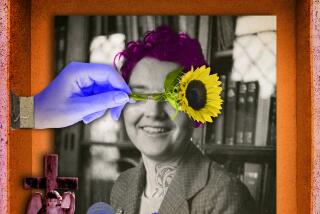The bell stops tolling
- Share via
SUSAN SALTER REYNOLDS — Art is the best weapon against death. Bach knew it, Michelangelo knew it, James Frey knows it (which is not to say that he isn’t a cheater, or that he actually belongs in such illustrious company -- he’s been included for his obvious joe-schmoe-ness), and Jose Saramago knows it. “Death With Interruptions” is his duomo, his Sistine Chapel, his allegoryparableliteraryphilosophysciencefictionnovelpaintingmusical composition.
In other words, one writer’s petition against mortality.
“New Year, New Life” -- so read the headlines one terrible New Year’s morning in a nameless country of 10 million inhabitants. The crisis? Eternal life. No one dies for an entire week. A country in the throes of suspended life, arrested death. An interdisciplinary commission is created: Newspaper editors, ministers, clairvoyants and cardinals are consulted. The insurance companies, as you can imagine, are in an uproar. The Catholic Church mourns the liberation of death. The people soon realize that, to liberate their loved ones, they must smuggle them out of the country under cover of darkness.
The government, in its infinite wisdom, tries to find death. Like Osama bin Laden, death eludes them. They assume death is a woman; a kind of bizarre profiling ensues -- is she dolichocephalic or brachycephalic? “The case of god is different,” the author concedes. “However hard he tried, he could never manage to make himself visible to human eyes.” Death, as so many writers have attested, is female, skeletal with large eye sockets and a scythe, often dressed in a sheet.
As a concession, death begins sending out letters in violet envelopes (Willy Wonka comes to mind) to give people who are going to die a week to organize their affairs.
Much to her surprise, one of the letters is returned to sender.
Up to this point in the novel (around halfway through), Saramago parades his status as author. In long sentences with questionable punctuation, he allows the voice of a runaway mind to narrate the story, intervening periodically until the reader feels both annoyed and powerless. You want to swat Saramago away, like a fly. Humanity seems ridiculous, with its fear of death and its desire for death. Just when you start to feel the author’s artifice, his self-consciousness, the burden of so many years writing literary fiction, something unexpected happens. Saramago lets himself write a good old-fashioned love story.
The man in death’s cross hairs is a 50-year-old cellist. He lives with his dog. He is a good man who has never been in love. One day, talking with his orchestral colleagues, he decides that his musical portrait can be found in a particular Chopin etude -- Opus 25, No. 9, in G-flat major, a 58-second piece -- “because of its tragic brevity, its desperate intensity, and also because of that final chord, like an ellipsis left hanging in the air, something yet to be said.” Death goes to see him. The dog sits in her lap. She hears him play. Still, she is determined to deliver the letter.
Death takes a week from her ordinary duties, leaving her scythe to handle things. She buys a dress, checks into a hotel and goes to hear the cellist play a solo in a concert. He sees her, alone in a box in the audience, and falls in love. “He plays as if he were bidding farewell to the world, as if he were at last saying everything that he had always kept unsaid, the truncated dreams, the frustrated yearnings, in short, life.” She waits for him after the performance.
But does she deliver the letter?
Why did Saramago, who won the Nobel Prize for literature in 1998, write this strange, gorgeous novel? He is fond of allegory -- political, spiritual, literary. Like so many magical realist writers, he likes to play God. He is a master of digression. Saramago has been a member of the Portuguese Communist Party since 1969. He writes about human affairs with an irony that is close to cynicism -- the kind of irony that protects an old softy who dearly loves human weakness. Saramago has always, in his writing, put a human face on things like loneliness, abuse of power, greed. He is also 85, which means he must be wondering what death really looks like.
It could have gone either way, another hallmark of Saramago’s novels. Rage against death, fierce irony, condescension toward this pathetic human existence or melting, fearless creative vulnerability. The cellist’s dog licks his hand when its master is sick from love, in love with death. He gets the cellist up and out to the park for a walk.
--
More to Read
Sign up for our Book Club newsletter
Get the latest news, events and more from the Los Angeles Times Book Club, and help us get L.A. reading and talking.
You may occasionally receive promotional content from the Los Angeles Times.






